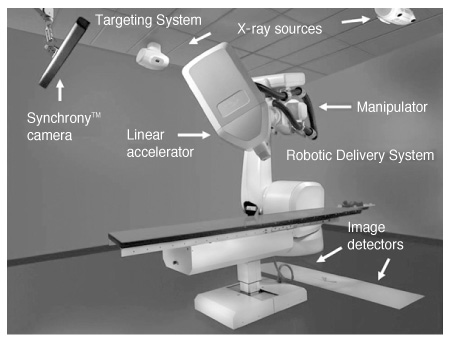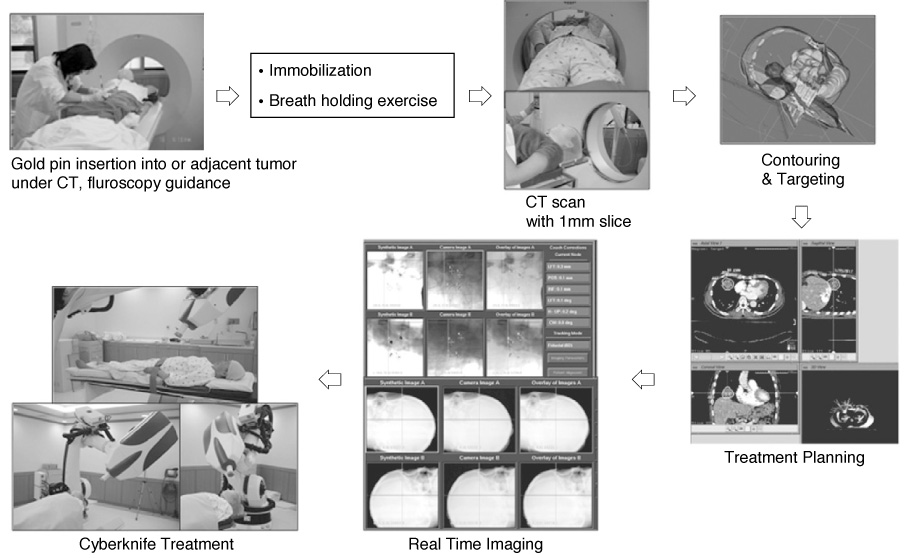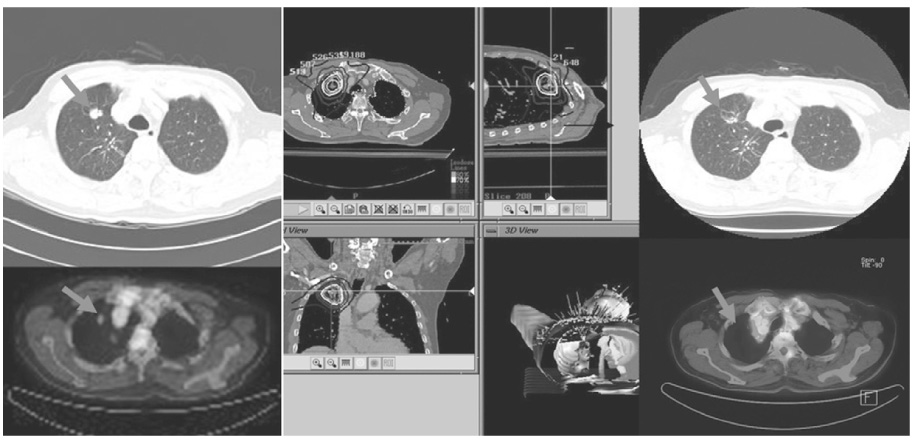J Korean Med Assoc.
2008 Jul;51(7):630-637. 10.5124/jkma.2008.51.7.630.
Cyberknife Robotic Radiosurgery System for Cancer Treatment
- Affiliations
-
- 1Department of Radiation Oncology, The Catholic University of Korea College of Medicine, Korea. yeonkim7@catholic.ac.kr
- KMID: 2185913
- DOI: http://doi.org/10.5124/jkma.2008.51.7.630
Abstract
- The Cyberknife is an integrated image-guided, frameless radiosurgery system. The physical component includes a compact 6 MV X-band linear accelerator mounted to the mobile arm of a robotic manipulator and a real- time imaging system connected to a remote image registration console. Two orthogonally positioned diagnostic x-ray cameras provide real time images of the patient's internal anatomy during treatment. The images are processed automatically to identify radiographic features, such as skull bone landmarks or implanted fiducials and are then automatically compared with digitally reconstructed image of the patient's planning CT. In this processing, the direction of the radiation beam is continuously re-adjusted to reflect any changes in the patient position. An analysis of the accuracy of the Cyberknife radiosurgery system found that the machine has a clinically relevant accuracy of 1.0 +/- 0.3mm. While clinical results with intracranial lesions are comparable to frame-based radiosurgical technique using gamma-knife or linac, recent experiences demonstrate the potential to broadly expand the scope of radiosurgery to many extracranial sites especially for cancer patients. The major potential benefit of radiosurgical ablation of malignant tumors are relatively short treatment time in an out-patients setting combined with better local control of the tumor with minimal risk of side effects. Cyberknife radiosurgery offers a new and alternative therapeutic modality for the medically inoperable early cancers, previous irradiated sites, and difficult lesions not amenable to open surgery, as a boost therapy with surgery or external radiation therapy or for rapid symptom relief of palliative care patients. While we are encouraged by excellent local control of early clinical experiences of Cyberknife, we also stressed the importance of long term follow-up results.
MeSH Terms
Figure
Reference
-
1. Gibbs IC, Chang SD, Adler JR. Mould RF, editor. Cyberknife radiosurgery experiences at Stanford University. Robertic Radiosurgery. 2005. 1st ed. Sunnyvale: The Cyberknife Society Press;3–38.2. Gerszten PC, Burton SA, Ozhasoglu C, Vogel WJ, Quinn AE. Mould RF, editor. Cyberknife radiosurgery: Single fraction therapy for spinal tumor. Robertic Radiosurgery. 2005. 1st ed. Sunnyvale: The Cyberknife Society Press;171–186.3. Gagnon GJ, Henderson FC, Collins BT, McRac DA. Mould RF, editor. Radiosurgery in previously irradiated spines. Robertic Radiosurgery. 2005. 1st ed. Sunnyvale: The Cyberknife Society Press;161–170.4. Brown WT, Wu X, Wen BC, Fowler JF, Fayad F, Amendola BE, Garcia S, De La Zerda A, Huang Z, Schwade JG. Early results of Cyberknife image-guided robotic stereotactic radiosurgery for treatment of lung tumors. Comput Aided Surg. 2007. 12:253–261.
Article5. Yoo EJ, Kim YS, Park HJ, Yoon SC, Jang HS, Chung SM. Cyberknife radiosurgery for primary or metastatic lung cancer, early clinical results of Catholic Medical Center. J Korean Soc Ther Radiol Oncol. 2007. 25:S.6. Onishi H, Shirato H, Nagata Y, Hiraoka M, Fujino M, Gomi K, Niibe Y, Karasawa K, Hayakawa K, Takai Y, Kimura T, Takeda A, Ouchi A, Hareyama M, Kokubo M, Hara R, Itami J, Yamada K, Araki T. Hypofractionated stereotactic radiotherapy (Hypo-FxSRT) for stage I non-small cell lung cancer: Updated results of 257 patients in Japanese multi-institutional study. J Thoracic Oncolgy. 2007. 2:94–100.7. Choi CW, Kim MS, Cho CG, Yoo SY, Yang KM, Yoo HJ, Lee DH, Ji YH, Han CJ, Kim YH. Locally advanced, unresectable pancreatic cancer treated by stereotactic radiation therapy. J Korean Soc Ther Radiol Oncol. 2006. 24:11–20.8. Suh YS, Yoo SY, Cho CK, Kim MS, Yang GM, Yoo HJ, Choi CW, Lee DH. Cyberknife radiosurgery results for head and neck cancer. Proceeding of the 3rd Annual meeting of the Korean Radiosurgery Society, 44(S).9. Kim YS, Jang JS, Kim MS, Kang JH, Yoon SC, Chung SM, Jang HS. Cyberknife radiosurgery for locally recurrent head and neck cancer. Proceedng of 6th annual Cyberknife user's meeting.10. Kim YS, Jang JS, Kim MS, Sun DI, Kang JH, Jung SR, Yoon SC. Improving local control with Cyberknife radiosurgery boost after external RT in locally advanced head and neck cancers. Proceeding of the 3rd Annual meeting of the Korean Radiosurgery Society, 50(S).
- Full Text Links
- Actions
-
Cited
- CITED
-
- Close
- Share
- Similar articles
-
- Localized Esophageal Ulcerations after CyberKnife Treatment for Metastatic Hepatic Tumor of Colon Cancer
- Cyberknife radiosurgery for inoperable recurred oral cancer
- Dosimetric comparison of volumetric modulated arc therapy with robotic stereotactic radiation therapy in hepatocellular carcinoma
- A Case of Acute Injury in the Stomach and Duodenum after Cyberknife Therapy
- Clinical Results of Cyberknife(R) Radiosurgery for Spinal Metastases





